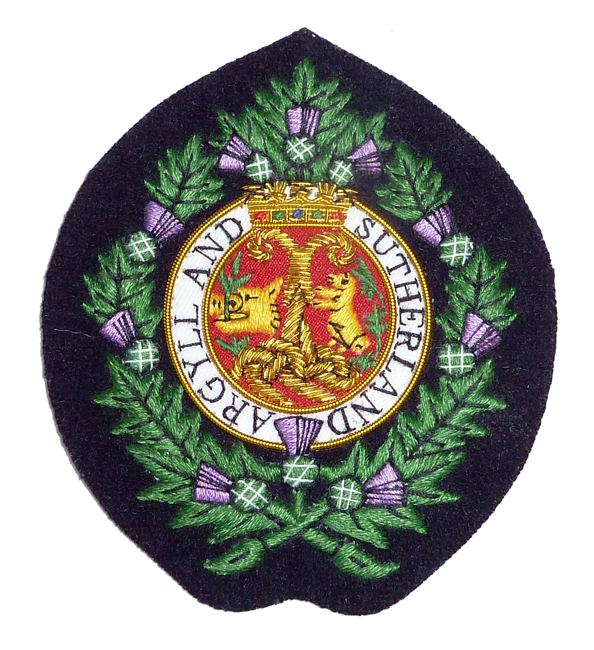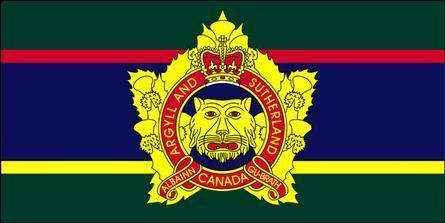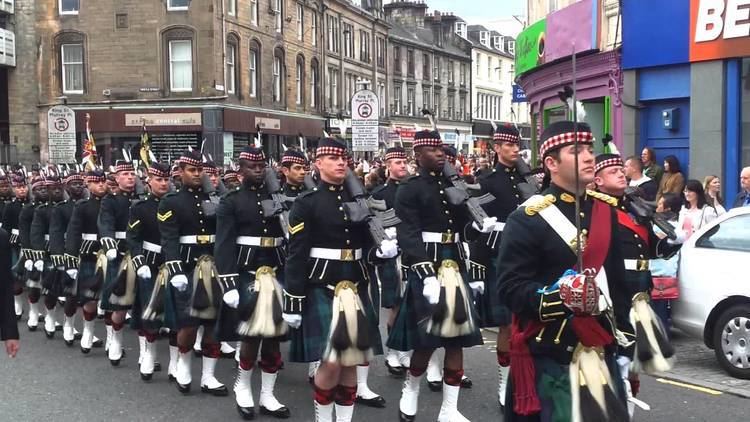Country United Kingdom Size One reinforced company | Role Public duties | |
 | ||
Active 1 July 1881 – 28 March 2006 | ||
The argyll and sutherland highlanders of canada remembrance day parade 2014
The Argyll and Sutherland Highlanders (Princess Louise's) was a line infantry regiment of the British Army that existed from 1881 until amalgamation into the Royal Regiment of Scotland in March 2006.
Contents
- The argyll and sutherland highlanders of canada remembrance day parade 2014
- Argyll and sutherland highlanders of canada p l change of command 3 jun 2012
- Formation
- Second Boer War
- Regular Army
- Territorial Force
- New Armies
- Second World War
- After the War
- Museum
- Battle honours
- Colonels in Chief
- Regimental Colonels
- Affiliations
- References

The regiment was created under the Childers Reforms in 1881, as the Princess Louise's (Sutherland and Argyll Highlanders), by the amalgamation of the 91st (Argyllshire Highlanders) Regiment of Foot and 93rd (Sutherland Highlanders) Regiment of Foot, amended the following year to reverse the order of the “Argyll” and “Sutherland” sub-titles. The Argyll and Sutherland Highlanders was expanded to fifteen battalions during the First World War (1914–1918) and nine during the Second World War (1939–1945). The 1st Battalion served in the 1st Commonwealth Division in the Korean War and gained a high public profile for its role in Aden during 1967.

As part of the restructuring of the British Army's infantry in 2006, the Argyll and Sutherland Highlanders were amalgamated with the Royal Scots, the King's Own Scottish Borderers, the Royal Highland Fusiliers (Princess Margaret's Own Glasgow and Ayrshire Regiment), the Black Watch (Royal Highland Regiment) and the Highlanders (Seaforth, Gordons and Camerons) into the seven battalion strong Royal Regiment of Scotland. Following a further round of defence cuts announced in July 2012 the 5th Battalion was reduced to a single public duties company called Balaklava Company, 5th Battalion, Royal Regiment of Scotland, (Argyll and Sutherland Highlanders).

Argyll and sutherland highlanders of canada p l change of command 3 jun 2012
Formation

It was formed in 1881 by the amalgamation of the 91st (Princess Louise's Argyllshire) Regiment and the 93rd (Sutherland Highlanders) Regiment as outlined in the Childers Reforms. The regiment was one of the six Scottish line infantry regiments, and wears a version of the Government Sett (Government No.2A) as its regimental tartan. It also had the largest cap badge in the British Army. The uniform included the Glengarry as its ceremonial headress.
At the Childers reform amalgamation the Argyll and Sutherland Highlander' already had a well-earned reputation for valour in the face of the enemy, most notably the 93rd (later 2nd Battalion Argyll and Sutherland Highlanders) during the Crimean War. Here, the 93rd earned the sobriquet of "The Fighting Highlanders" and carried with it the status of having been the original "Thin Red Line". This title was bestowed following the action of the 93rd at Balaklava on 25 October 1854 in which this single battalion alone stood between the undefended British Army base at Balaklava and four squadrons of charging Russian cavalry. The 93rd, under the command of Sir Colin Campbell, not only held steady, but for the first time in the history of the British Army, broke a large cavalry charge using musket fire alone, without having been formed into a square.
This action was witnessed by The Times correspondent, William Howard Russell, who reported that nothing stood between the Russian cavalry and the defenceless British base but the "thin red streak tipped with a line of steel of the 93rd" a description immediately paraphrased and passed into folklore as "The Thin Red Line". Later referred to by Kipling in his evocative poem "Tommy", the saying came to epitomise everything the British Army stood for. This feat of arms is still recognised by the plain red and white dicing worn on the cap band of the A and SH Glengarry bonnets.
Second Boer War
The 1st Battalion arrived in the Cape in November 1899 and formed part of the 3rd or Highland Brigade. The Argylls played leading roles in the Battle of Modder River, the Battle of Magersfontein, the Battle of Paardeberg and in an action at Roodepoort, immediately preceding the Battle of Doornkop. In June 1900, the battalion was transferred to a new brigade under Brigadier General George Cunningham. They operated around Pretoria and from April 1901, in the Eastern Transvaal. Sections of Argylls formed parts of the 2nd and 12th Battalions Mounted Infantry and a detachment, along with the Black Watch, formed an escort for Captain J E Bearcroft's naval guns during the advance to Pretoria.
Regular Army
The 1st Battalion landed at Le Havre as part of the 81st Brigade in the 27th Division in December 1914 for service on the Western Front. The 2nd Battalion landed at Boulogne-sur-Mer as part of the 19th Brigade, which was operating independently, in August 1914 for service on the Western Front.
Territorial Force
The 1/5th (Renfrewshire) Battalion landed at Cape Helles as part of the 157th Brigade in the 52nd (Lowland) Division in June 1915; the battalion was evacuated to Egypt in January 1916 and then landed at Marseille in April 1918 for service on the Western Front. The 1/6th (Renfrewshire) Battalion landed in France as part of the 152nd Brigade in the 51st (Highland) Division in May 1915; the battalion moved to Italy in November 1917 but returned to France in April 1918. The 1/7th Battalion landed in France as part of the 10th Brigade in the 4th Division in December 1914 for service on the Western Front. The 1/8th (The Argyllshire) Battalion landed in France as part of the 152nd Brigade in the 51st (Highland) Division in May 1915 for service on the Western Front. The 1/9th (The Dumbartonshire) Battalion landed in France as part of the 81st Brigade in the 27th Division in February 1915 for service on the Western Front.
New Armies
The 10th (Service) Battalion landed at Boulogne-sur Mer as part of the 27th Brigade in the 9th (Scottish) Division in May 1915 for service on the Western Front. The 11th (Service) Battalion landed at Boulogne-sur-Mer as part of the 45th Brigade in the 15th (Scottish) Division in July 1915 for service on the Western Front. The 12th (Service) Battalion landed at Boulogne-sur-Mer as part of the 77th Brigade in the 26th Division in September 1915 but moved to Salonika in November 1915. The 14th (Service) Battalion landed at Le Havre as part of the 120th Brigade in the 40th Division in June 1916 for service on the Western Front.
Second World War
The 1st Battalion fought in the Western Desert Campaign, Crete, Abyssinia, Sicily and in the Italian Campaign. The first action for the 1st Battalion was at Sidi Barani where they joined the battle on 10 December 1940 as part of the 16th Infantry Brigade. On 17 May 1941 the battalion moved to Crete where they formed part of the defence based on the east side of the island at Tymbaki. Most of the Argylls marched from Tymbaki to the airfield at Heraklion on the night of 24 May to help support the 14th Infantry Brigade in the fighting at that airfield. They were successfully evacuated on 29 May from Heraklion but their convoy suffered air attacks and many casualties on the route away from Crete. The Argylls left at Tymbaki were captured when the island surrendered. The 1st Battalion was shipped to Alexandria and after garrison duties followed by a raid into the Gondar region of Abyssinia, they were sent back to the Western Desert where they were eventually attached to the 161st Indian Infantry Brigade, part of 4th Indian Infantry Division, and fought in the Second Battle of El Alamein. In 1943 the 1st Battalion landed on Sicily during Operation Husky, the Allied invasion of Sicily, attached to the 5th British Infantry Division as the 33rd Beach Brick. From February 1944 the battalion fought through the Italian Campaign with the 19th Indian Infantry Brigade, attached to 8th Indian Infantry Division.
The 2nd Battalion fought valiantly against the Imperial Japanese Army during the fighting in Malaya and Singapore (See Battle of Bukit Timah). Led by the tough Lieutenant Colonel Ian Stewart they were one of the very few British units that was prepared for the jungle warfare in Malaya. In the months before the invasion of southern Thailand and Malaya in 1941, Stewart took his battalion into the harshest terrain he could find and developed tactics to fight effectively in those areas. This training that the 2nd Argylls went through would make them arguably the most effective unit in General Percival's Malayan Command, earning them the nickname "the jungle beasts". During the withdrawal of the 11th Indian Infantry Division the 2nd Argylls slowed the enemy advance and inflicted heavy casualties on them. During these actions the battalion became so depleted by battle that it was ordered back to cross the causeway into Singapore. Two days later, an Australian staff officer in company with the 2000 or so men of the 22nd Australian Brigade (the absolute tail guard of the British forces) arrived at the causeway. He was amazed to find all 250 of the ASHR, the proud remnants of the whole battalion who had been in action almost continually since the Japanese invaded six weeks previously, camped on the Malay side of the water. When asked what they were doing still in Malaya when they could have been in the relative comfort of Singapore their commanding officer, Ian Stewart, replied "You know the trouble with you Australians is that you have no sense of history. When the story of this campaign is written you will find that the ASHR goes down as the last unit to cross this causeway what's more – piped across by their pipers". Having suffered the massive loss of some 800 men due to being continuously used as the buffer to protect the retreating army (especially at the Battle of Slim River), the remaining Argylls, upon arriving in Singapore were reinforced with Royal Marines who had survived the sinking of HMS Prince of Wales and HMS Repulse in December 1941 changing their name to Plymouth Argylls (in reference to the Argylls affiliation to the Plymouth Argyle Football team and that all the Marines were from the Plymouth Division). The battalion surrendered with the rest of General Percival's army in Singapore in February 1942. Many Argylls died in captivity as P.O.W's or in the jungle trying to avoid capture. A few Argylls managed to escape to India, including Lt.Col.Stewart, where they lectured on Jungle warfare tactics. After this the evacuees became part of No.6 GHQ Training Team, which organised training exercises and lectures for the 14th Indian Infantry Division and 2nd British Infantry Division.
In May 1942, the 15th Battalion, raised during the war, was redesignated as the new 2nd Battalion. This battalion joined the 227th (Highland) Infantry Brigade and became a part of the 15th (Scottish) Infantry Division, a formation that would gain an excellent reputation, in 1943. With the division, the battalion fought in the Battle for Caen, seeing its first action in Operation Epsom, as part of Operation Overlord. The division ended the war on the Elbe River.
The 5th battalion landed in France as part of the British Expeditionary Force in September 1939. They took part in the Dunkirk evacuation in June 1940 and then, after converting to become the 91st Anti-Tank Regiment and seeing action at the Normandy landings in June 1944, they fought through North-West Europe to the River Elbe.
The 6th battalion landed in France as corps troops for I Corps with the British Expeditionary Force in September 1939. They took part in the Dunkirk evacuation in June 1940 and then, after converting to become the 93rd Anti-Tank Regiment, saw action in the Tunisia campaign, in the Allied landings in Sicily and in the Allied landings in Italy.
The 7th Battalion was a Territorial Army (TA) unit serving in the 154th (Highland) Infantry Brigade. The brigade was part of the 51st (Highland) Infantry Division in France in 1940 as part of the British Expeditionary Force. They were stationed on the Maginot Line and so avoided being encircled with the rest of the BEF during the Battle of France. The 7th Argylls in particular suffered heavy losses during the fighting, the worst day in its history. The 154th Brigade managed to be evacuated to England after the 51st (Highland) Division was forced to surrender on 12 June 1940. The division was reconstituted by the redesignation of the 9th (Highland) Infantry Division to the 51st. The understrength 154th Brigade of the old 51st was merged with the 28th Infantry Brigade. In 1942 the new 51st Division, 7th Argylls included, were sent to join the British Eighth Army in the North African Campaign. They fought in the First Battle of El Alamein and in the Second Battle of El Alamein which turned the tide of the war in favour of the Allies. During the fighting in North Africa, Lieutenant Colonel Lorne MacLaine Campbell of 7th Argylls was awarded the Victoria Cross. In March 1942, two British privates from the 7th battalion, Macfarlane and Goldie, escaped wearing their blue work detail overalls over their battledress. They wore rucksacks to cover the markings "KG" (Kriegsgefangener, "prisoner of war") on their backs. They secreted themselves in a rail wagon carrying salt to Belgium. There they managed to contact an escape line and, by the middle of the year, they were safely back in Scotland.
The 8th Battalion was also a Territorial Army (TA) unit serving with the 8th Battalion in the 154th (Highland) Infantry Brigade. The brigade was part of the 51st (Highland) Infantry Division in France in 1940 as part of the British Expeditionary Force. The 154th Brigade managed to be evacuated to England after the 51st (Highland) Division was forced to surrender on 12 June 1940. On 25 April 1943, the 8th Battalion was, by this time, serving with the 36th Brigade, part of the 78th Battleaxe Division during the Tunisian Campaign won fame during the assault of Djebel Ahmera hill on the attack on Longstop Hill, in which despite heavy casualties from mortar and machine gun fire scaled and took the heights. Major John Thompson McKellar Anderson for inspiring his men and eliminating strong points gained the Victoria Cross.
After the War
Between 1945 and 1948 the 1st Battalion saw service in Mandatory Palestine, during the conflicts with the Jewish paramilitary organisations Irgun, Haganah and Lehi.
In 1948, the 2nd Battalion was amalgamated with the 1st Battalion. The battalion was one of the first British units to serve in Korea, arriving there in September 1950 as part of the 27th British Commonwealth Brigade. Its first major action, in the battle of Naktong, the battalion was involved in a tragic friendly fire incident, in the fight for Hill 282. The Argylls were noted for their reoccupation of the Crater district of Aden, under controversial Commanding officer, Lieutenant Colonel Colin Campbell Mitchell, during the Aden Emergency in the mid 1960s.
In 1970, the Argyll and Sutherland Highlanders, as the junior regiment of the Scottish Division, faced disbandment as part of a general downsizing of the army. A "Save the Argylls" campaign involving the petitioning of Parliament resulted in a compromise under which a single regular company retained the title and colours of the regiment. "Balaclava Company" continued as an independent unit from 20 January 1971 until the regiment was restored to full battalion size on 17 January 1972. Between 1972 and 1974 detachments from the regiment regularly served in Northern Ireland at the height of the Troubles. In Spring 2004 the regiment was engaged in some of the fiercest fighting of the Iraq War.
In 2006, as part of the restructuring of the infantry, the Argyll and Sutherland Highlanders were amalgamated with the other Scottish infantry regiments into the single Royal Regiment of Scotland. The regiment's last role before amalgamation was in the air assault role as part of 16 Air Assault Brigade. Elements of the new regiment originally affiliated with the Argyll and Sutherland Highlanders included a regular battalion (5 SCOTS), an affiliated company of the Territorial Army battalion, 51st Highland Volunteers (7 SCOTS) and an Army Cadet Force battalion. The 5th Battalion continued recruiting in the area allocated to the Argylls, wore a green hackle on its headdress to differentiate it from the other battalions, and were permitted to use the title "The Argyll and Sutherland Highlanders" in reference to the battalion.
On 5 July 2012, a further series of measures to reduce the total size of the British Army were announced by Defence Secretary Philip Hammond. These included the reduction of 5 SCOTS (Argyll and Sutherland Highlanders) to a single company (Balaklava Company) for public (ceremonial) duties in Scotland. The Queen visited the Highlanders at Howe Barracks in Canterbury in June 2013 to mark their relocation to Scotland.
Museum
The Argyll and Sutherland Highlanders Regimental Museum is the regimental museum of the Argyll and Sutherland Highlanders, their antecedent regiments and successor battalions. Located in Stirling Castle, the museum building was built in the 1490s, and known as the "King's House" or "King's Old Building", thought to have been the private residence of King James IV. Entrance to the Museum is included in the price of the castle entrance ticket. The museum is almost entirely maintained through public donations; the modest grant from the Ministry of Defence has been withdrawn. It is governed by a charitable trust: The Argyll and Sutherland Highlanders Museum Trust.
Battle honours
The regiment's battle honours include:
Colonels-in-Chief
Regimental Colonels
Colonels of the regiment were:
Affiliations
Units that have formed affiliations with the regiment include:
